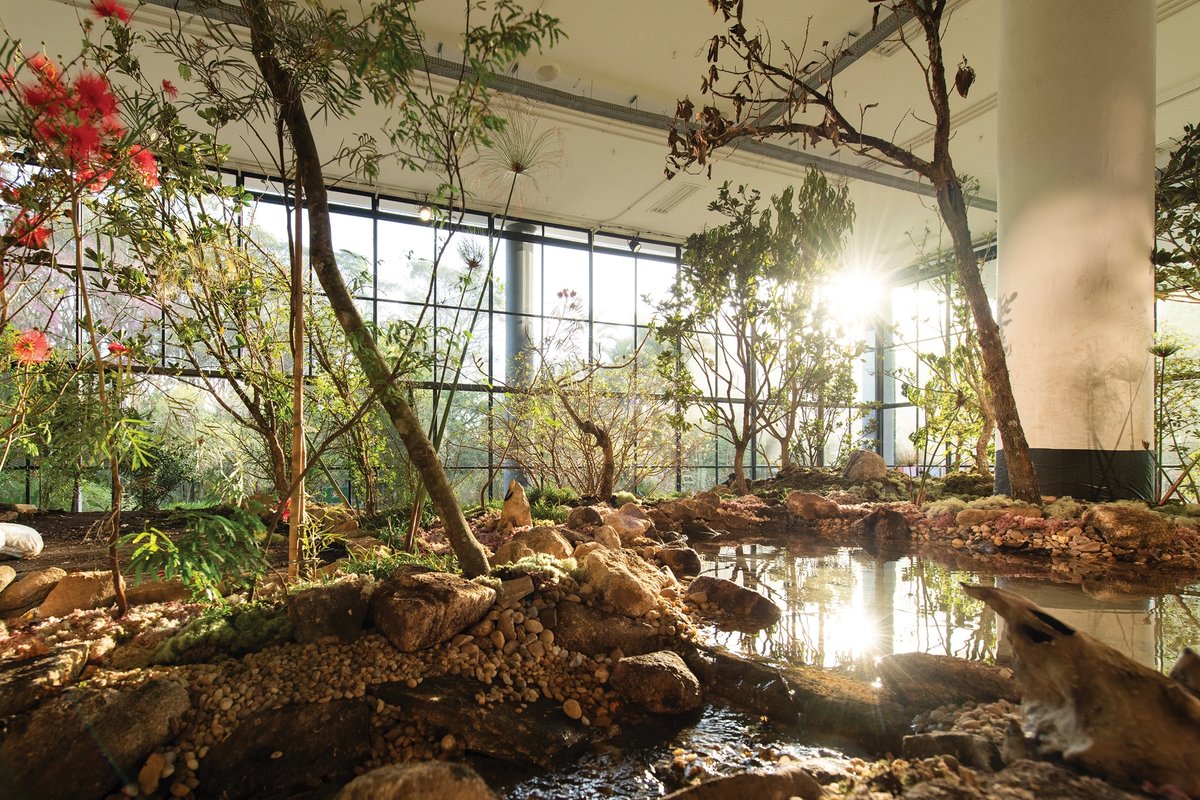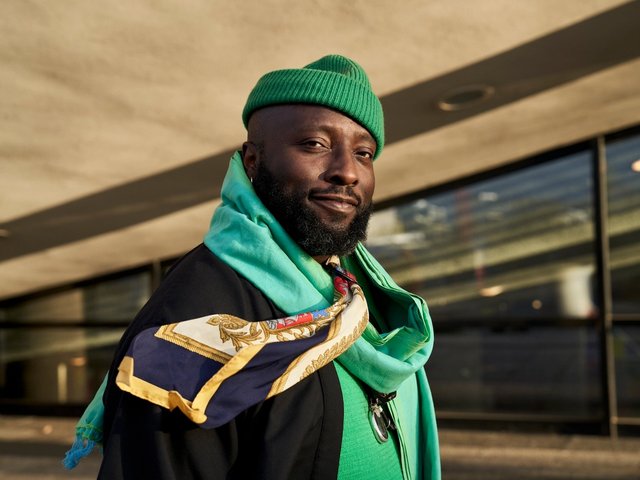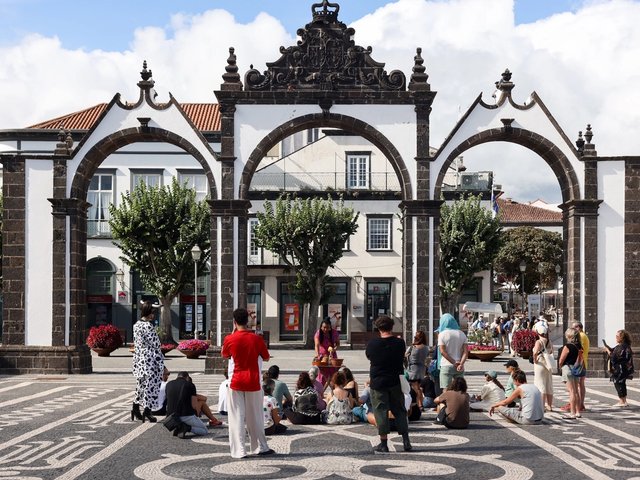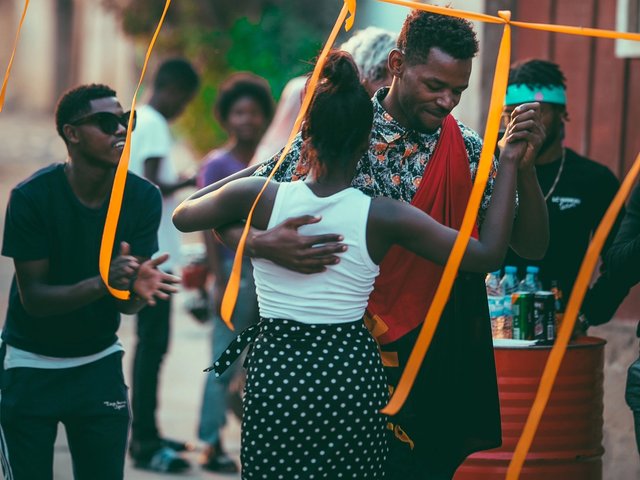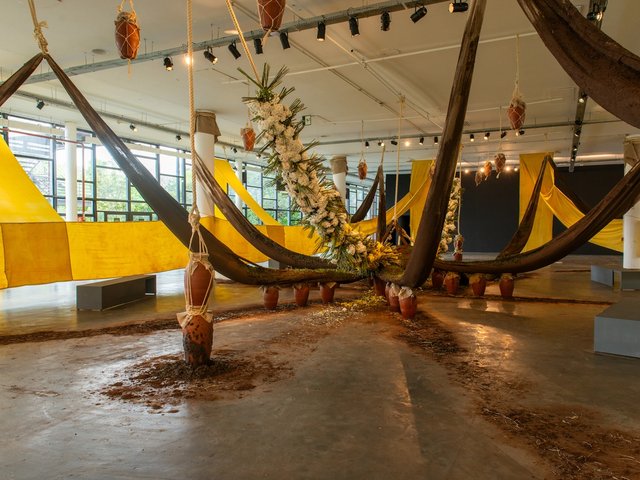The 36th Bienal de São Paulo opens with the striking site-specific installation Sun of Consciousness. God Blow Thru Me – Love Break Me (2025) by the Nigerian-American artist Precious Okoyomon, comprising a spiralling path of moss-covered earth, waterfalls and other organic and sculptural elements that evoke the biome of the Cerrado, a region of Brazil that has been widely deforested. Okoyomon’s time in the Minas Gerais state and as an artist-in-resident at the newly launched Casa Onze in São Paulo extensively informed the work. It develops upon the artist’s presentation at the 59th Venice Biennale in 2022, making connections between nature and sociopolitics.
The work sets the tone for the biennial. Like Okoyomon, many participating artists are exhibiting work in Brazil for the first time and investigating Brazilian themes. The work is embedded with nuanced poetics, nodding in its title to Édouard Glissant, one of the writers who is said to have inspired much of the thinking behind the biennial. The piece also continues a previously celebrated project but now with a Brazilian twist.
Meanwhile, the organising team is thoroughly international; the Cameroonian chief curator Bonaventure Soh Bejeng Ndikung has been assisted by curators from Morocco (Alya Sebti), Switzerland (Anna Roberta Goetz) and Brazil (Thiago de Paula Souza and Keyna Eleison) alongside the German communications advisor Henriette Gallus.
The theme
To begin to understand the biennial it is helpful to try and unpick its title: Not All Travellers Walk Roads— Of Humanity as Practice. It partly references a poem by the Afro-Brazilian writer Conceição Evaristo. In her poem, the word viandante—which is translated here as “traveller”—is closer in meaning to a pilgrim or an existentialist. The second part of the title references what the curators call “practicing humanity as a verb”, a concept that has many loose interpretations in the biennial, where lofty terms like “conjugating humanity” are used throughout.
During the opening weekend, a local gallerist remarked: “I didn’t really understand the theme. Did you?” And it does seem like the biennial sometimes gets lost in its lyricism, maybe because the theme of “humanity as practice” is so all-encompassing that one could make an argument for the inclusion of almost any work of art. Most of the pieces on show, more than half of which were commissioned for the exhibition, are visually compelling and have good backstories, but some just do not feel at home in the biennial, or are so on-the-nose that they seem slightly flat.
Strength and weakness
For example, one of the most anticipated elements was a career-spanning presentation by the British artist Frank Bowling. More than 20 paintings—the second-largest artist presence in the biennial, behind the Brazilian artist Gervane de Paula—are dispersed throughout the Ciccillo Matarazzo Pavilion, including commissioned works like Agnes and September (both 2025), which take the outline of Brazil as their subject. The works continue Bowling’s longtime colour field paintings that focus on borders and imperialism. But his other paintings fade into the background of the show, begging the question of whether this significant presentation could have been more impactful elsewhere.
The columns of the Oscar Niemeyer-designed pavilion are splashed with lengthy and uninviting texts that explain—in a somewhat “art speak” tone—the six “chapters” of the exhibition, which have long and nebulous titles: Frequencies of Arrivals and Belongings; Grammars of Insurgencies; On Spatial Rhythms and Narrations; Flows of Care and Plural Cosmologies; Cadences of Transformation; and The Intractable Beauty of the World. Their Portuguese translations are not much clearer.
Quality, not quantity
This edition of the biennial features 125 artists, including 97 international artists and 28 Brazilian artists. When questioned about the roster, Ndikung said the curators were “not focused on numbers” but rather “artists, Brazilian or otherwise, who bring depth and sociopolitical engagement”. He added that having a predominantly foreign curatorial team may have its advantages: “Sometimes, when you are too close to something, you cannot see it clearly. Someone from far away may reveal it differently.”
The previous edition in 2023—organised by the Brazilian curators Diane Lima and Hélio Menezes, the Portuguese artist Grada Kilomba and the Spanish historian Manuel Borja-Villel—was primarily centred on Brazil, with themes like the Afro-Brazilian religion Candomblé, the plight of Indigenous and Afro-Brazilian people, and the military dictatorship. It was a stronger biennial although reviews were also mixed; some thought it was too Brazilian, while foreigners who had no familiarity with Brazil struggled to follow. But if the last biennial felt inaccessible to the unprimed viewer, this biennial feels alienating to everyone.
The best works look to nature as a metaphor. Marlene Almeida’s Terra Viva (Living Earth) (2025)—an installation made from suspended textiles dyed with native plants and minerals—powerfully conjures the beauty and abundance of the Brazilian landscape. Antonio Társis’s Orchestra Catastrophe: Act I (2025) consists of tapestries made from electronic waste and other materials, referencing his upbringing in a favela and the polluting effects of human consumption. And Rebeca Carapiá’s copper and iron sculptures Como criar raízes aéreas (How to Create Aerial Roots) (2025) evoke the paxiúba, also known as the walking palm, which moves toward sunlight, symbolising resilience against inequality.
Performance power
Another strength of the biennial is its performance programme, held inside and outside of the pavilion in collaboration with 13 Brazilian and 15 foreign cultural institutions, including the Tanoto Art Foundation from Singapore and the Center for Art, Research and Alliances from New York.
As part of the programme, the Casa do Povo in São Paulo hosted one of the most memorable moments of the opening weekend, the performance Batucada (2014-ongoing) by the Brazilian choreographer Marcelo Evelin. Masked performers began slowly drumming Brazilian beats on things like pots and oil cans and softly nudging the audience as they circled around the room, with their drumming and physicality becoming gradually more intense as the crescendo built and the performers disrobed. The room was musky with sweat when the hour-long work ended. As the audience followed the performers onto the street they were forced to move around their bodies to exit.
This performance particularly stood out, maybe because it was punctuated by the kind of visceral feeling that the biennial touted but seemed to lack at times. It was also uniquely Brazilian, using the energy of percussive Afro-
Brazilian drumming to speak to sociopolitical tensions and power struggles without being didactic. It seemed to be almost universally understood and felt by the audience. Some had covered their ears during the performance, prompting one artist to scoff: “You didn’t come to Brazil to see another Documenta.”
• Ciccillo Matarazzo Pavilion, São Paulo, until 11 January. Curator: Bonaventure Soh Bejeng Ndikung. Tickets: free. The works: ★★★★. The show ★★★
What the other critics said
In The Guardian, Oliver Basciano gives the show three stars: “meditation and spiritual connection may be OK in small doses, but after three floors and 30,000 sq. m of darkened rooms [and] a general encouragement to be moved, mesmerised and in touch with my spiritual side ... I feel quite on edge”.
In Art Review, Mateus Nunes says the exhibition design “emerges as [the] most contentious point, a multilayered issue” and he “expected this Bienal to push harder against the Modernist austerity of Niemeyer’s white edifice”.


